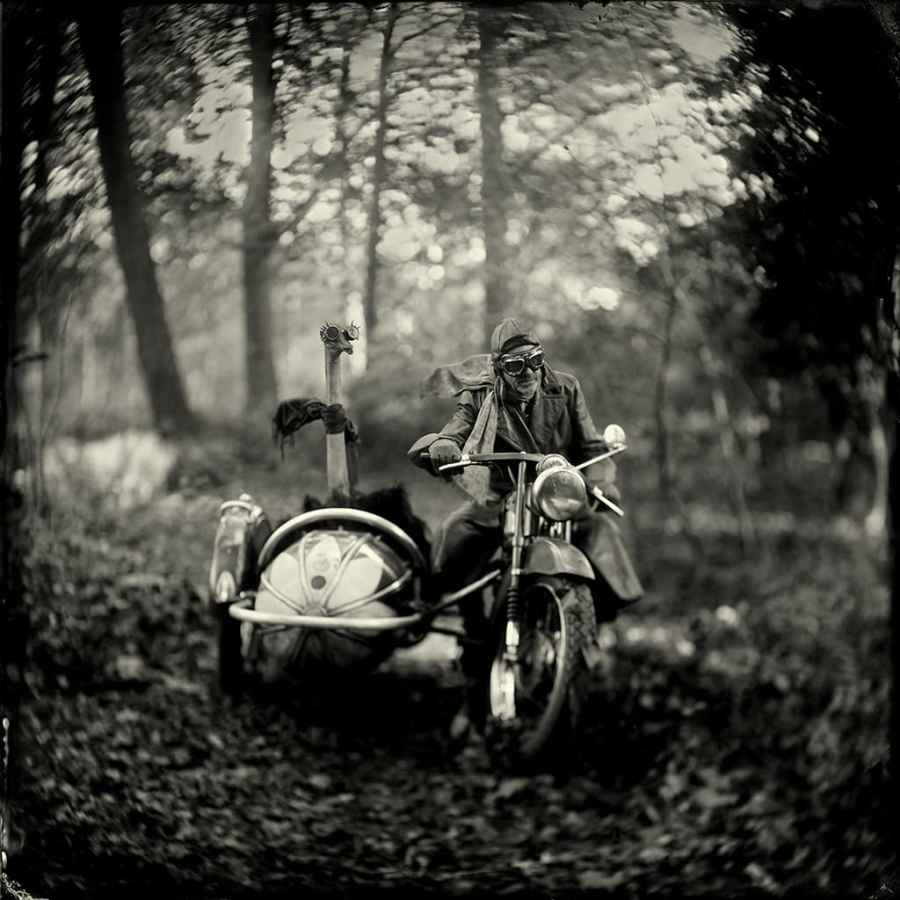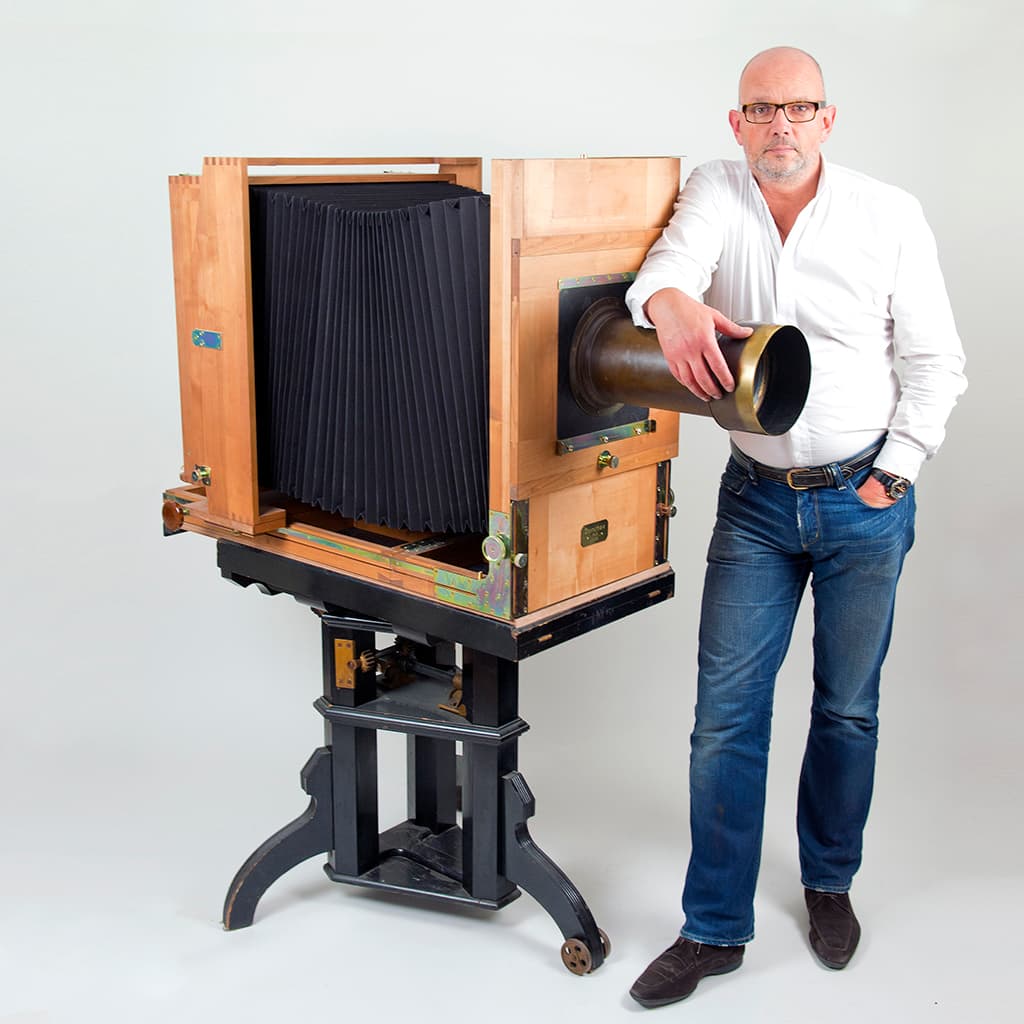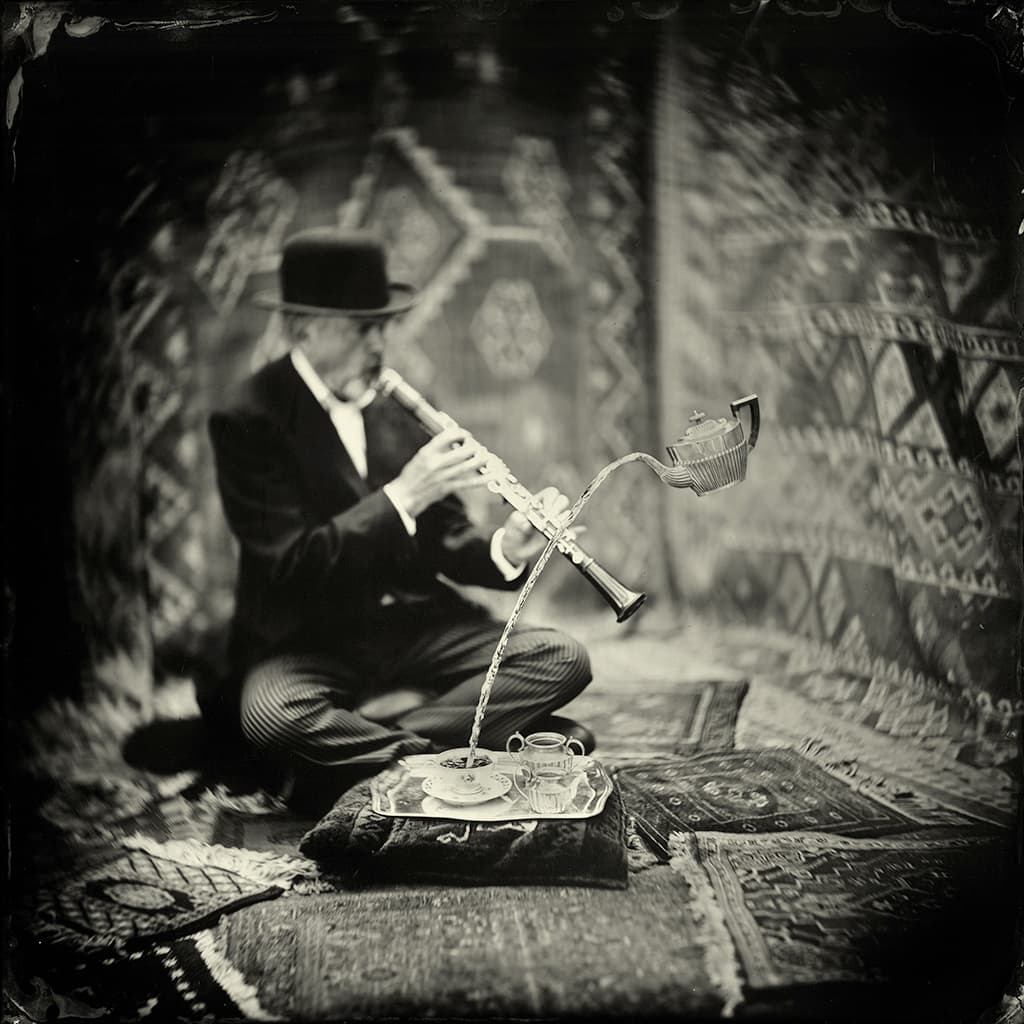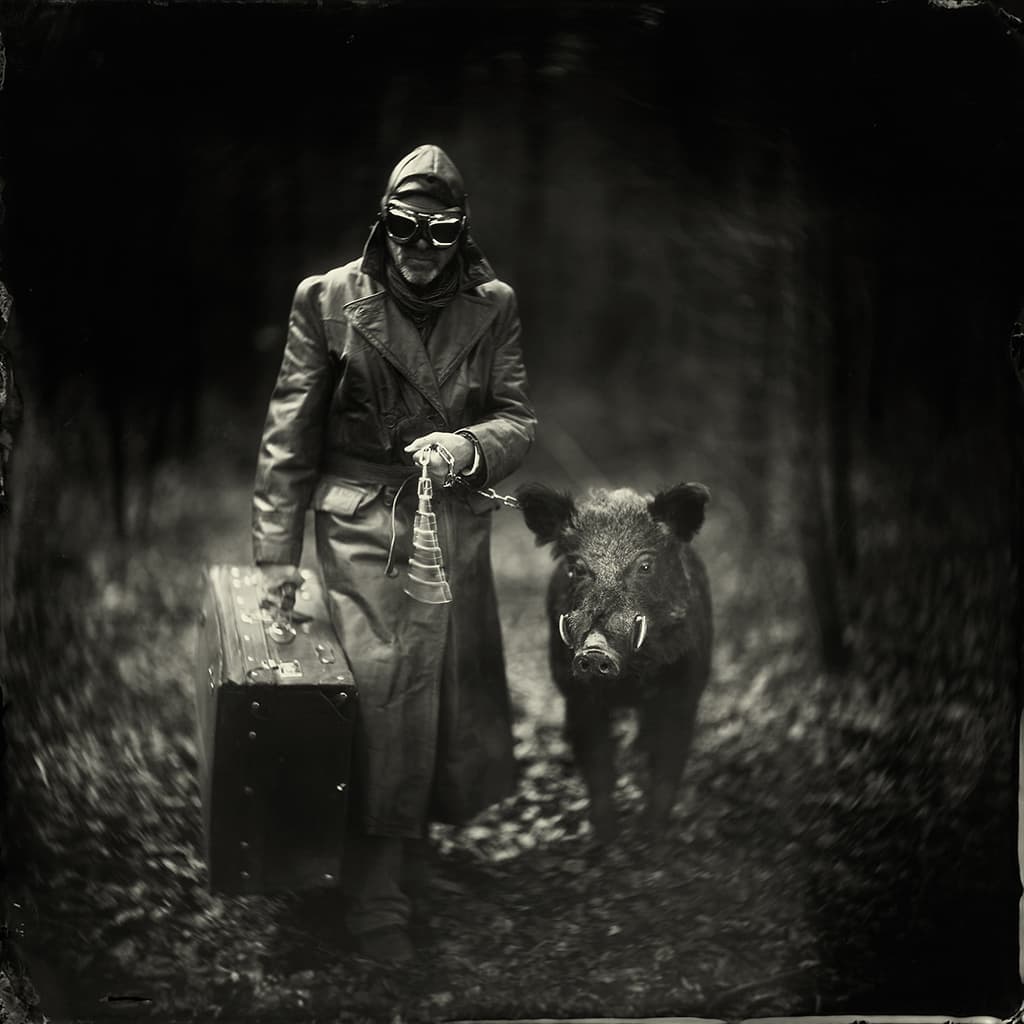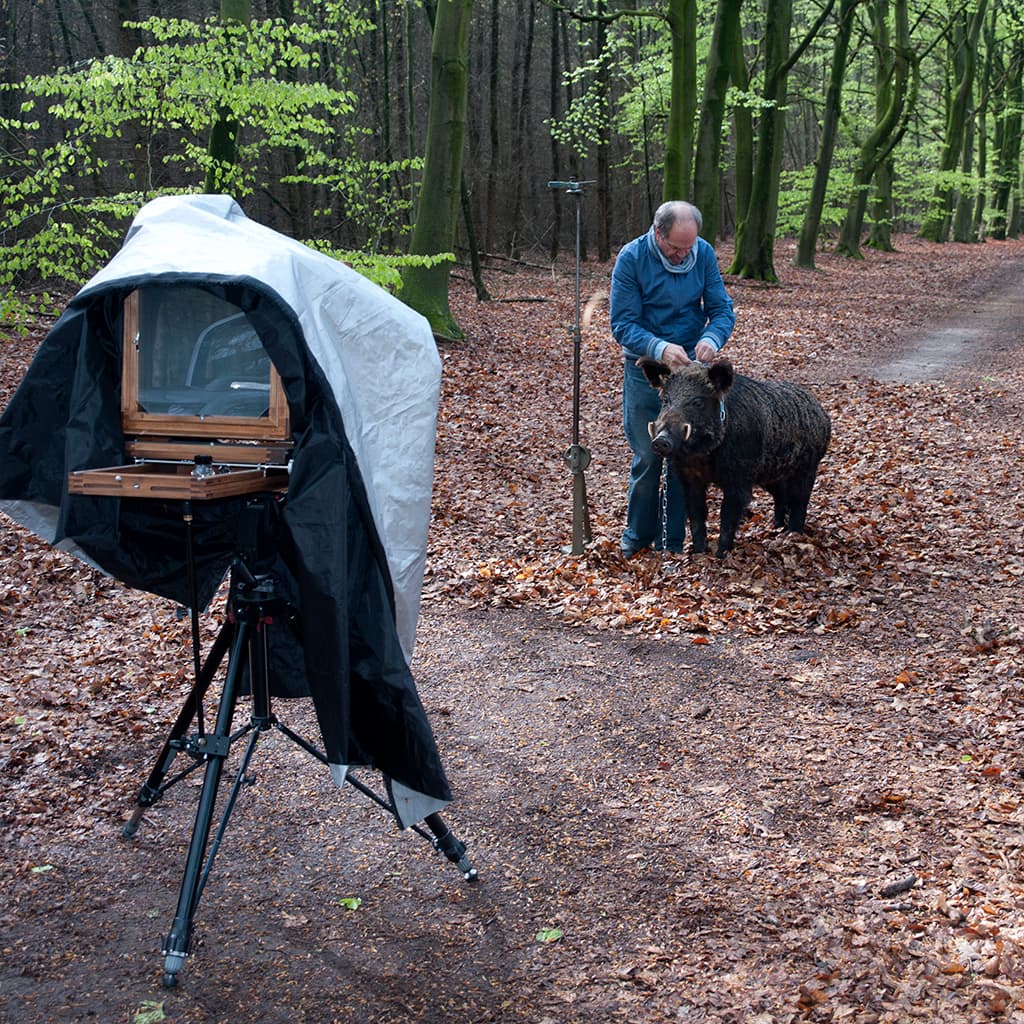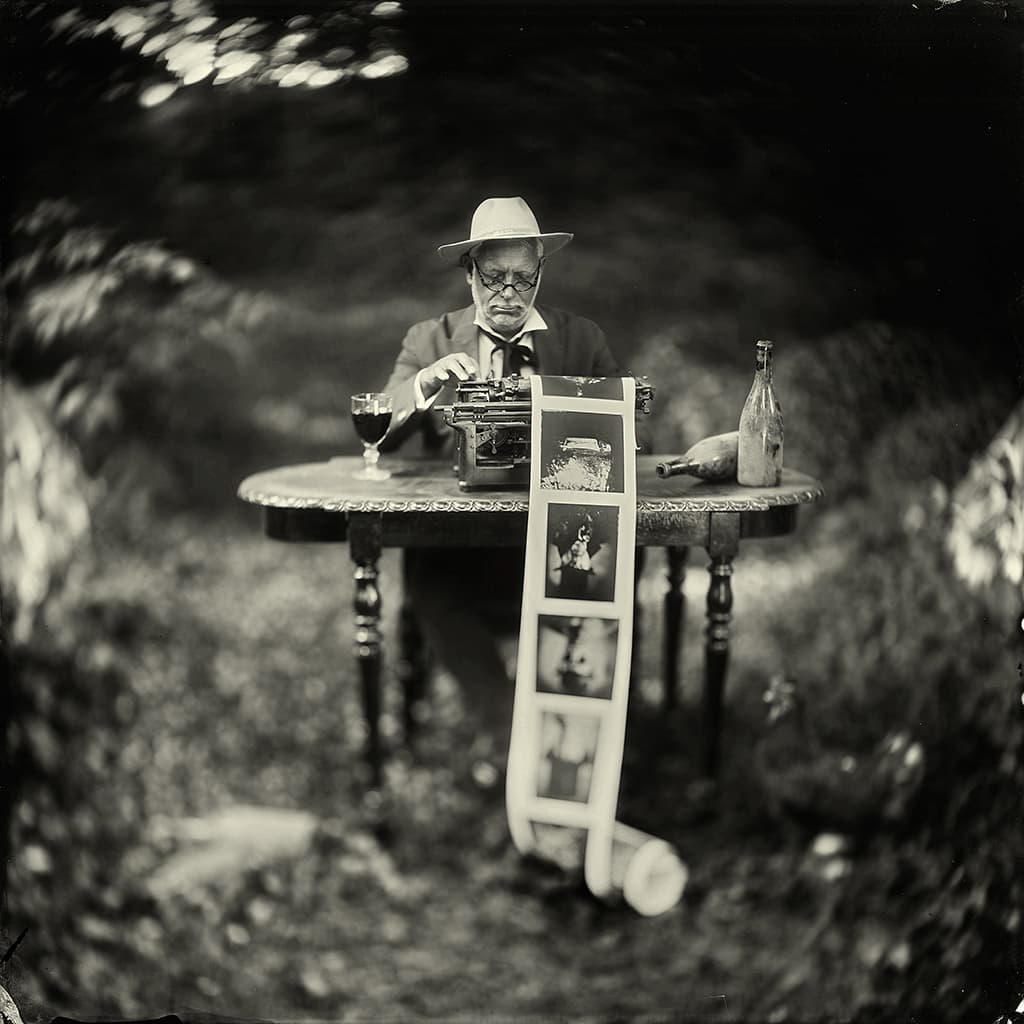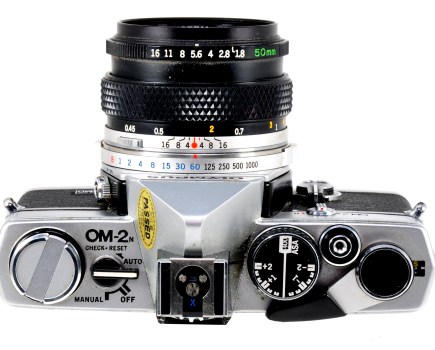Photographer Alex Timmermans tells Damien Demolder why he uses the wet-plate process to bring his carefully planned situation comedies to life
Finding a niche isn’t every photographer’s aim. Some of us are happy to shoot to a decent standard while mastering our kit and making a pleasant composition that maybe appeals to more than just ourselves. If you want your photography to stand out though, a niche is a useful thing. If no one else is working that way, shooting that type of subject or processing their images in the same way, your work will automatically look different.
The problem with a niche is that it won’t stay a niche very long. As soon as other photographers admire what you are doing they will be inspired by your work and begin doing it themselves. As more take it up the niche-value diminishes; and when others start doing it better, new faces take the spotlight.
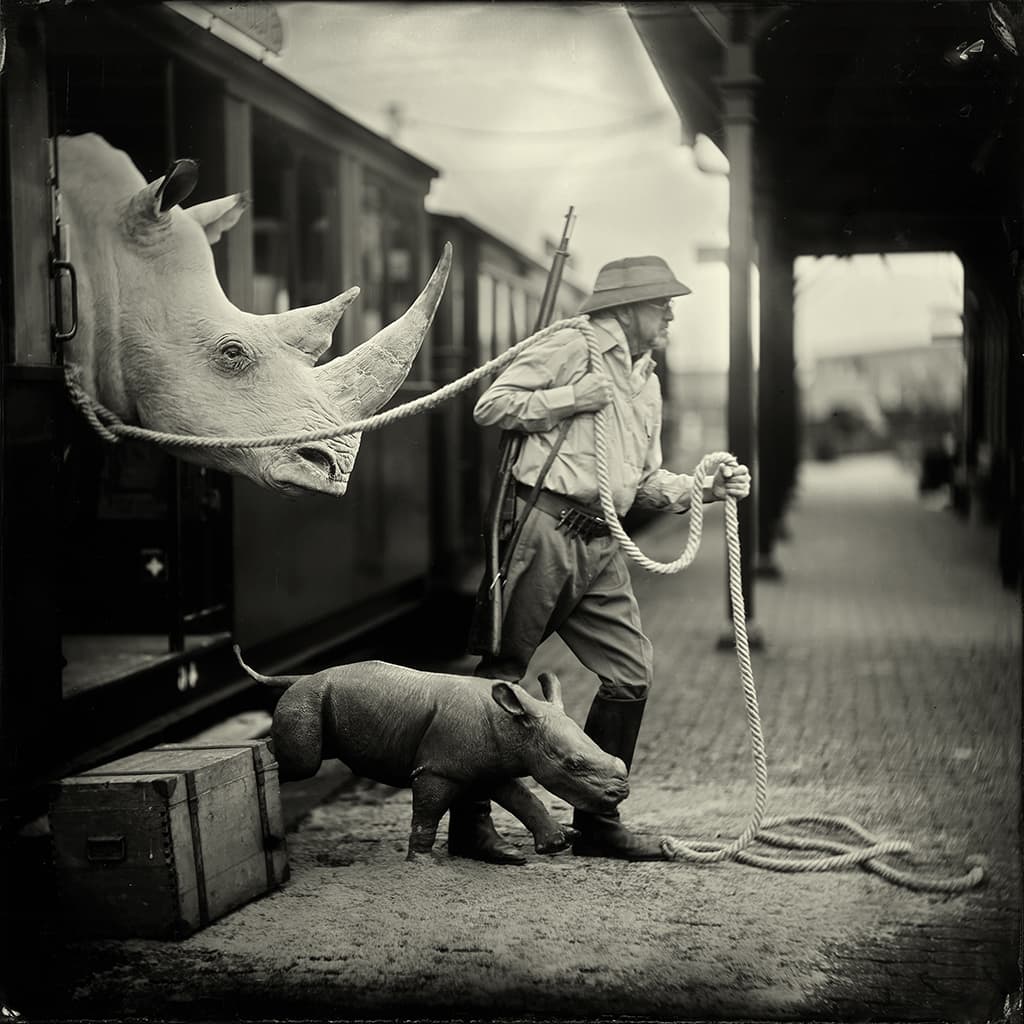
Alex had to build a structure to support the plastic rhino head to make it appear to belong to a whole one
The best way to ensure you remain unique is to move away from a former niche once it no longer qualifies as one – which isn’t easy. You then need to find another, or to combine two niches in one to make it much harder for anyone to take up doing the same thing.
‘I started off doing wet-plate portraits,’ says Dutch photographer Alex Timmermans, ‘but there was no challenge. Someone would come in with a good face, you’d take the picture everyone would say, “wow”, but eventually it stopped being a challenge and there were too many photographers doing the same thing. That’s when I started the story-telling series.
I wanted to do something else with the process that other people were not, and still are not – shooting outside and creating images with some humour in.’ Thus combining one niche with another – the uniqueness of an ancient process and humour – Alex has been able to create a series of pictures that are really special.
Nitrous nitrate
‘There are very few photographers using humour in their pictures,’ Alex says, and as I think about it I have to agree. ‘There’s a photographer called Rodney Smith who makes humorous pictures and he inspires me. I don’t know how the ideas come – I can’t explain how these stupid things turn up in my mind all day.
Sometimes I see a prop that sets off an idea, or a location, and then I get carried away. The pictures take a lot of planning and thought, so I only make about five or six every year.
I like creating things. I come up with an idea and then start collecting the props. The picture might only take a few seconds but the fun is in the planning, working out how to achieve the look and making the things I need.
It’s great when people like the pictures. Some people hate them and don’t think they are funny – that’s also good. I love to stand back at exhibitions and watch people looking at the images. When they smile I know that I’ve reached my goal.
‘I started with wet plate in 2008 because I saw an exhibition of Sally Mann’s and was impressed with the look and feel of the pictures. So I wanted to know more. My work is different from hers of course, but there is a similar atmosphere to the images. Wet plate was the start of my artistic phase of photography. In 2002 I bought a Fujifilm S2 Pro digital camera, which was a revolution at the time. It was an amazing camera, and I loved it.

Alex is fascinated by the things he imagines about what butlers are asked to do, and what they do in their spare time
One broke and I took it apart and was surprised to see that inside you could see there was a film bay as it was based on a film camera. I shot urban pictures, which wasn’t popular then. You’d go to a location, take 300-400 pictures and share your pictures and then suddenly there would be too many people turning up at that location. I spent a lot of time in Photoshop, but my software skills are limited – and it turned out this wasn’t what I was looking for.
I wanted to create and do it from scratch – which I still do. Now I use old cameras, make my own chemistry, scan the plates and make my own prints. The only thing I do in software now is remove the dust from the plates. I like to control the whole process. Controlling the process is very important to me, as I don’t want to rely on someone else.
That’s not to say no one else has the skills, but I want a consistent look to my work and the way it is displayed – I even make the frames for my exhibitions. If someone buys one of my pictures, then buys another a few years later and hangs them next to each other, I want to make sure that they have the same look and feel.’
The making of
‘My pictures look like they are done in Photoshop as some of them look impossible to do any other way, but they are all done in-camera. I don’t have the skills to fake a rhino coming off a train, and while there are smartphone apps now that do a convincing job of turning any picture into a ‘wet-plate’ shot, I like my own process. It is possible to do all this with a digital camera, but I like to use old lenses that create a magical atmosphere.’
Alex gathers props from around the world for his pictures, makes some himself and often has to build parts of sets and supports to create his trickery. Teapots that appear to pour themselves are attached to the tea-cup with aluminium rods covered in silicone to make the rod look like flowing tea; and boats, ballerinas and pianos are set on underwater platforms to make them appear to float.
‘Underwater platforms have to be made the day before the shoot so I can match the water level, and they are always made adjustable so I can rise or lower them should I need to. It’s a lot of effort, but that’s what gives me so much pleasure. Making the props and working on the ideas is almost more fun than making the picture itself. Making the picture takes one to ten seconds, but planning the picture can take years.
‘I was in the pub with some friends discussing my ideas, and asked if someone would help me as I needed someone to look after my camera while I was in the van processing pictures. One of my friends agreed, and has also become the subject of most of my pictures, dressed as the butler or the motorcyclist – not the ballerina though.

The graceful ballerina isn’t actually balanced on a lily pad – both she and the stuffed swan are on a specially built platform
Most of the time it is just the two of us, but sometimes we are three when I need someone else in the shot or some behind-the-scenes pictures. I had a solo exhibition at Paris Photo in Los Angeles in the Paramount Studios. On the opening night there were lots of movie stars and directors there, and they all asked “How big is your team?” They wanted to know about the staging, makeup, lights and crew, and they couldn’t believe it was just the two of us. They are used to ten or 20 people on set.
‘My two biggest problems are having the idea in the first place and then finding the props. At the moment I’m planning a picture around golf, so I’m looking for old clubs, old outfits, golf knickerbockers (I found these in the UK!). It all takes a long time. It can take two years to finalise the idea in my head, and then the search for props begins.
If I would need an assistant it would be just to find props. That would make life much easier. Sometimes I see things that look interesting and then find a way to include them in a picture. I found a puma and then spent a year thinking about how to use it in a picture. It ended up in the front of a canoe on a river.
I had an ostrich in my studio for three years before it found a place in the side car of a motorbike racing through the forest. My studio is full of props. I have a motorcycle outside my door that I bought three months ago, and I’m thinking about how to use it. The rhino in the train picture is just a plastic wall mount, but I had to find an old station, which isn’t easy in the Netherlands, and an old train of course.’
Movement in stills
There is often a real sense of movement in Alex’s pictures, though of course with his long exposures there is rarely any allowed on set. ‘For shots like the motorcyclist with the ostrich I used wires in the scarf to make it fly behind him as though he was zooming towards the camera. It isn’t possible to shoot a moving motorbike with a wet-plate camera, but we can make it look as though it is moving. This was a ten-second exposure, but the swirl of the lens creates its own sense of motion in the picture.
I also tilted the camera back to throw the front wheel and some of the background out-of-focus which adds to the feeling of motion. To emphasise the background swirl of the lens you need a background with small leaves and light coming through them, or a background with lots of detail. In a portrait in the studio against a plain backdrop it doesn’t show.’
Delightful defects
‘I love this process. Well, it can be love and hate as there are so many variables that can influence the result, including the weather and temperature. If it’s too bright I don’t take pictures because I prefer to have an exposure of 4-6 seconds.
There is no shutter in my camera so I’m just taking the lens cap off and putting it back on again, so it is hard to be accurate. In a long exposure a mistake of half a second matters much less than if the total exposure time was supposed to be just one second.
‘Many people are using wet plate because of the artefacts and the weird errors that can happen, but really the challenge is to make a clean plate. Creating artefacts isn’t hard – you just need a dirty plate-holder. Making a clean-looking plate is the goal though. You can always make a clean shot look dirty later in software, but you can’t make a dirty plate look clean.
Marks around the edges can’t be avoided and are normal – which is why you see lots of old plates with masked edges. Showing defects in your process can sometimes work artistically, but usually it doesn’t. I like to show the whole plate, so I don’t mask mine. But you certainly shouldn’t see defects in the face of a portrait.
‘Depending on the picture, I like to make the most of the faults of the lens – so I shoot in natural environments as much as I can, as this shows them off. Ferns look particularly magical when shot on wet-plate so I often look for locations that have the characteristics that work well with the lens. ‘Collodion reacts to colours in a different way to film. Red will turn black, and light blue will turn white, so I have to make sure I pick the right colours in the props and the clothes to get the effect I want.
Blue eyes come out really light, which can make them look piercing, while brown eyes and freckles will go really dark, which looks unique and magical. Sometimes weird things can happen though – when you shoot a banana and a lemon next to each other the banana will appear bright and the lemon will be as dark as an avocado. Leather is beautiful in wet-plate – it has a special glow.’
Big brass barrels
‘I started with a camera that takes 11in square plate, which is an unusual size. It I could do it again I’d chose 8x8in which would be much easier to find a shutter for. My lenses are too big for shutters. I had the camera made because I needed a portable camera but field cameras aren’t sturdy enough to take the wide-aperture lenses I wanted to use, and studio cameras – which can hold the lenses – aren’t portable.
I picked the lens first, and had the camera made to suit it. ‘I wanted tilt and swivel for the back and for the front to rise and fall. While I’ve hardly used rising front I use tilting back in almost every shot. ‘The camera is made of cherry wood and it weighs 10kg, but a studio camera would have been even heavier. I mount it on a normal aluminium Manfrotto tripod. ‘My lenses are old Petzval models from 1850-1900 – big brass lenses.
I have too many as I collected them, but I realised I was using only two or three, so I sold most of the others – though I still have more than I should. My main lens is a big brass Hermagis from Paris and I have a few Dallmeyer lenses with longer focal lengths. The Dallmeyer lenses are a bit younger – around 1900 – and are made from aluminium so they are a lot lighter. My Dallmeyer 600mm lens only weighs 2kg, which makes it easier to use than the Hermagis lens which weighs about 4kg.
‘In the forest I use the Hermagis as it has a lot of swirl and the aperture starts at f/4.5. My Dallmeyer lenses mostly start at f/6. It doesn’t sound like there’s much difference in the maximum apertures but it really shows in the pictures – f/4.5 gives a much shallower depth of field, which I really like.
I take a few lenses with me and decide when I see the conditions, as the weather plays a big part in my lens choices. When photographing someone in a river or a pond I can use a longer lens and shoot from the shore or a wider lens and move the tripod and camera into the water too, which I do sometimes.

‘These are simple lenses, but beautiful. You don’t need lots of fancy stuff. I like the fact that I’m working with a very simple camera and a simple lens – looking at the image on the ground glass is magical. It gives me back the feeling of making something.
‘I have an iPhone app called Pinhole Assist that allows ISO ratings down to zero which I use for metering exposure, but with experience you come to know what the exposure should be. It is more difficult on a bright day as the process is very sensitive to UV light which we don’t see. Then you can only tell from a test plate.
Normally I shoot four or five plates per shoot, which I process in the field. I have a van that I use as a darkroom as I have to sensitise the plate directly before making the picture, and I have to process it immediately before it dries. Sometimes I’ll find a fantastic location but I can’t use it if I can’t get my van there. I have too much stuff to carry without the van. ‘I use the Epson 1000XL scanner and an Epson wide format printer to make prints between 11x11in and up to 110cm.’
Tips for the newcomer
‘Book a workshop for one or two days so you can see what you can and can’t do. The process isn’t that difficult, and mixing the chemicals is easy, but you need to practise to get better as lots of small things can go wrong. You’ll be amazed that the images are so detailed.’
Further reading
Get the retro look with vintage lenses
Photographer gears up to take ‘Mega Mammoth’ wet-plate camera across America

